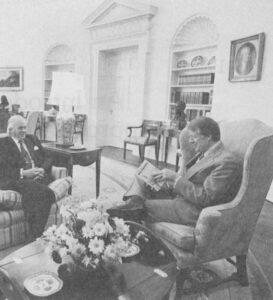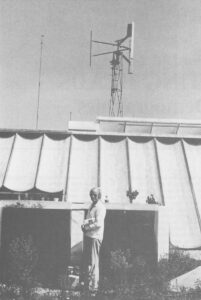Imagine, if you can, a region of, say, 100,000 people within which all food is locally raised, buildings are constructed from local materials, energy is harnessed from local power sources and all goods necessary for a healthy existence are made using locally available resources and skills. In theory at least, inhabitants of such a region would have direct control over all the basics of life. Moreover, they would be free from influences that might otherwise be imposed from without. They could lead a free and self-fulfilling life guided by their own inclinations rather than the more impersonal, possibly self-alienating ones of large-scale, distantly controlled organizations and networks.
 Such is the utopia glimpsed by many adherents of a small but growing movement which perhaps will prove to be the most important new one to emerge in the U.S. in the last quarter of the 20th Century. The movement advances under the unlikely banner of technology-” appropriate (or alternative or soft) technology” or “AT” for short-but its aims are profoundly, if not always explicitly, political.
Such is the utopia glimpsed by many adherents of a small but growing movement which perhaps will prove to be the most important new one to emerge in the U.S. in the last quarter of the 20th Century. The movement advances under the unlikely banner of technology-” appropriate (or alternative or soft) technology” or “AT” for short-but its aims are profoundly, if not always explicitly, political.
“Question authority” urges a bumper sticker I picked up at an appropriate technology fair last summer, in Amherst, Massachusetts. It is an all-purpose, sociologized exhortation that could have come out of the rebellious sixties. And indeed, not far beneath the surface-a surface that I suspect for some AT questioners of authority is welcomed as protective coloring-there simmers in many AT breasts a sixties-style design to overhaul society. Not necessarily by confronting and overpowering existing institutions, but by rendering them technologically irrelevant. To apply sixties talk to AT’s late-seventies goals, appropriate technologists see whole communities dropping out of the system, to the point where they become the system themselves or, by standards of the anarchistic undercurrent of some AT thinking, the non-system. As a social movement, AT is “aimed at decentralizing economic and political power through the promotion of alternative technologies.” That’s the way one participant put it the other day at a gathering to discuss the politics of appropriate technology, a panel discussion, with cheese and wine, featuring some of the main political analysts of the movement, most of them sympathists as well.
As a conscious, inevitably self-conscious, movement, the AT cause has been active and growing in the U.S. for more than two years now, from at least early 1977 when the late E. F. Schumacher, author of Small Is Beautiful and the principal prophet of appropriate technology, toured the U.S. for six weeks and drew large crowds in the name of smallness at every stop. That there was beginning to be a political significance to AT then was evident in the appearance at many of Schumacher’s stops of leading politicians, including governors and U.S. Senators; at tour’s end, Schumacher had a private audience with President Carter at the White House. How did political analysts of the movement think the movement has been advancing politically since then, I wondered. To find out, I attended the panel discussion, titled “The Power of Alternative Power: Assessing the Political Significance of the Appropriate Technology Movement,” which was held in a seminar room at George Washington University, in Washington.
As befitting a cause, one of whose principal bywords is decentralism, no unanimous viewpoint emerged from the group. However, a general, troubled sense of transition was one common undercurrent, centered in part on the question of whether the movement’s profounder aims may be threatened by its own superficial successes.
Countless local, state and federal agencies have taken up the AT cause of late, or have at least invoked the name of appropriate technology. David Morris, co-director of the Institute for Local Self-Reliance, a Washington-based, AT-minded group, recited a list of new AT governmental programs and offices-even the National Science Foundation, a citadel of establishment science and technology, is currently considering a major program in appropriate technology-and ambivalently observed: “The movement is becoming institutionalized and increasingly dependent on the public sector.” Craig Decker, who is producing a periodicas and is working on a thesis at MIT on appropriate technology and community development, agreed. “There is a nice myth about AT being completely a grassroots phenomenon,” he said, “but for better or worse, the impetus for AT is now coming from government.”
Another speaker, Mary Ann MacKenzie, indicated that she thought there was little evidence so far that the impetus has been for the better. She works for the Community Services Administration, parent body of the main federal AT organization, the National Center for Appropriate Technology, and on her own time, she is the main coordinator of an informal Washington-centered group called Friends of Appropriate Technology (FAT). She said, “I’ve seen a lot of the good work that some of us have begun not necessarily destroyed but certainly disturbed by traditional politics.” Later she elaborated: “What’s happening in government, I think, is that they’re allowing us to exist … [but] 99 per cent [of government] is still going headlong in the opposite direction. “
Not everyone was dubious about government’s role in appropriate technology. Congressman George Brown of California, one of the House’s principal advocates of appropriate technology, was represented at the meeting by an aide, Tim Lynch, who took issue with the notion that government involvement in appropriate technology was at best a mixed blessing. “In defense of institutionalizing the AT movement,” he said, “there’s a danger, but if we don’t institutionalize what we’re talking about, we won’t be able to talk about it over a long period of time.”
Inculcating an appropriate technological viewpoint into the agencies of government and politics was important, Lynch argued, because conventional technological approaches, powerfully embodied in such agencies, are subject to little challenging from within or without. “That’s partly because the scientists and engineers and technicians have sold us on the idea that technology and science are value free, which is nonsense. R and D programs orient society with a set of biases, a set of values, and that’s what is happening today in all the research institutions. They already have a vision of the future, which is what they’re developing, and you’ve got to get in on the ground level and start changing [this vision].”
Lynch suggested that significant AT in-roads into government not only were worth pursuing but were in effect already happening, at least in his home state. He cited Governor Jerry Brown’s landslide reelection in November as evidence of the political power of AT thinking, noting that Brown’s support of AT-styled alternative energy technologies, such as solar power, was a main campaign issue. Denton Morrison, a professor of sociology at Michigan State University, on leave to study the AT movement as a Woodrow Wilson Center fellow in Washington, similarly saw AT political successes in the gains of the anti-nuclear movement. “I don’t think anyone in their right mind would bet very much on the future of nuclear energy [in the U.S.] today,” he said. “And the flip side of the anti-nuke movement is appropriate technology. It’s very much part of the thinking of the anti-nukes.”
In discussing politics and appropriate technology, the panelists tended to divide, into two main camps, those who were looking at how politics was, or was not, furthering the cause of AT, and those who focused more on how, or if, alternative technology could change the nature, or composition of politics. A fundamental premise of the AT movement is that the nature of our society, including our economics and politics, is determined in large measure by our technology. We have large corporations and large centralized government, this view holds, because technology both permits and reinforces such conglomerations. One way to diffuse power, according to such thinking, is to develop and spread techniques and tools by which relatively small communities, even individual households, can be largely self-sufficient.
But at least two panelists, both British, doubted whether technology itself could be significantly changed without changing the power structures that determine what technological styles predominate to begin with. “The fundamental question, I would argue, is not over the appropriate type of technology, whether we want a hard technology, whether we want a mainstream technology or this, that or other type of technology. The fundamental question is who is going to have control over that technology.” David Dickson, author of The Politics of Alternative Technology and Washington correspondent of Nature, the British science magazine, was the arguer. Colin Norman, a senior researcher at Worldwatch Institute, who wrote a recent report for the Institute titled “Soft Paths and Hard Realities,” seconded the notion. “Many AT technological solutions will fail because of an emphasis on using technology as a way of changing society, rather than the reverse … Unless you can introduce appropriate technologies along with social and political changes, such as cooperatives, community organizations, changing land ownership, changing the credit system … AT is not going to solve the problem.”
Panelist Craig Decker, in assessing the political future of appropriate technology, saw the AT movement responding to such realizations and broadening its scope. “What’s most likely to happen, and you see it happening already, is that the 70’s have been a decade of different efforts to change society through technological means- technology assessment, the environmental movement and so on. I think what you’re seeing at the end of the 70’s is a disillusionment with trying to effect social change through technical means and the energy moving towards more direct social action… I think probably as you move into the 80’s you’ll see people who have been advocates of AT and have been doing funky local things moving into trying to create national coalitions for social change.”
Perhaps. Certainly Decker’s prognosis reflects an inclination within AT ranks that was evident at the panel session itself-a desire to move beyond the impersonal arena of technology into more openly political concerns and activisms. But my own sense is that this inclination stems mainly from early ATers who are long familiar with the movement’s ambitious aims, impatient with its so far undramatic accomplishments and wary of its adoption by others, individuals and institutions, that they deem less truly guided by the visions and values of appropriate technology. The movement’s main message has only begun to get across meanwhile, I think, and there is plenty for ATers to do to get it across before taking on society as a whole. The very idea that technology is not neutral and not necessarily dictated by the laws of science and the marketplace, that it may come in a range of styles and scales, that are subject to explicit, possibly democratic choice, is a profoundly unfamiliar and radical one that takes a long time to absorb in a society that has tended to leave technology mainly to the technologists and businessmen. This notion may prove to be the major contribution, with immense social and political implications, of the AT movement, and it is only beginning to penetrate the popular consciousness, I suspect, including that of the politicians and bureaucrats.
Meantime, as Professor Morrison noted, the movement apparently is benefiting from its appeal to a broad ideological spectrum and diversity of interests: alongside the barely restrained sixties-style activists are small businessmen, tinkerers, counter-culturalists, human potentialists, environmentalists, and so forth. Decker made much the same point in assessing the movement’s current strength. “The very way appropriate technology has had some of its successes,” he said, “is that it’s been nebulous enough to be many things to many people, and I think that’s why it’s attracted a broad base of support. Each person defines it sort of differently but they all say we’re all talking about the same general thing.”
But, he went on, this is a “double-edged sword. It creates a broader movement, but when you get down to specifics, you’re going to have real tension within the movement.”
Part of the internal politics of appropriate technology, in fact, would appear to be a vying by different interests that have found comfort, and perhaps shelter, under the AT umbrella, a vying to mold the movement and take advantage of its current fashionableness to further more specific causes. And this indeed is likely to cause tension; they were there, I thought, beneath the surface at least, among the discussants, who represented, ultimately, different flanks of the movement. David Morris, for instance, the Institute for Local Self-Reliance co-director, much of whose work has been in Washington’s poorer and blacker neighborhoods, took the movement and implicitly some of his fellow panelists to task, because the movement “still has not embraced equity as an issue” Mary Ann MacKenzie reflected feminist priorities in openly berating the panel discussion’s organizers for having only one woman, her, on the panel and even that as an afterthought. (I’ve seen the proposition that AT is inherently more feminist, or at least more feminine than conventional technology; the case is a bit metaphysical and metaphorical and I’m not sure I follow it, but it illustrates the eagerness to link other current causes with AT.)
In any case, at least one panelist, Professor Morrison, suggested that the cause of appropriate technology might best be furthered by keeping politics and government out of the act. “Maybe it doesn’t call for a large political coalition in which you squeeze the power structure. You just let things happen.” And at least one other, Ms. MacKenzie, suggested that not much would happen until the current system (technological and otherwise) collapsed from its own flaws. “My sense is that the system is going to collapse, and when the system collapses, there will be some of us who have some fragments of skills and community… and another lifestyle that will allow us to continue on.”
By such thinking, not uncommon in AT circles, in the ultimate politics of appropriate technology Utopia may after all have to wait on Armageddon.
©1979 Wade Greene
WADE GREENE ends his Fellowship study on the Appropriate Technology Movement with this issue.





